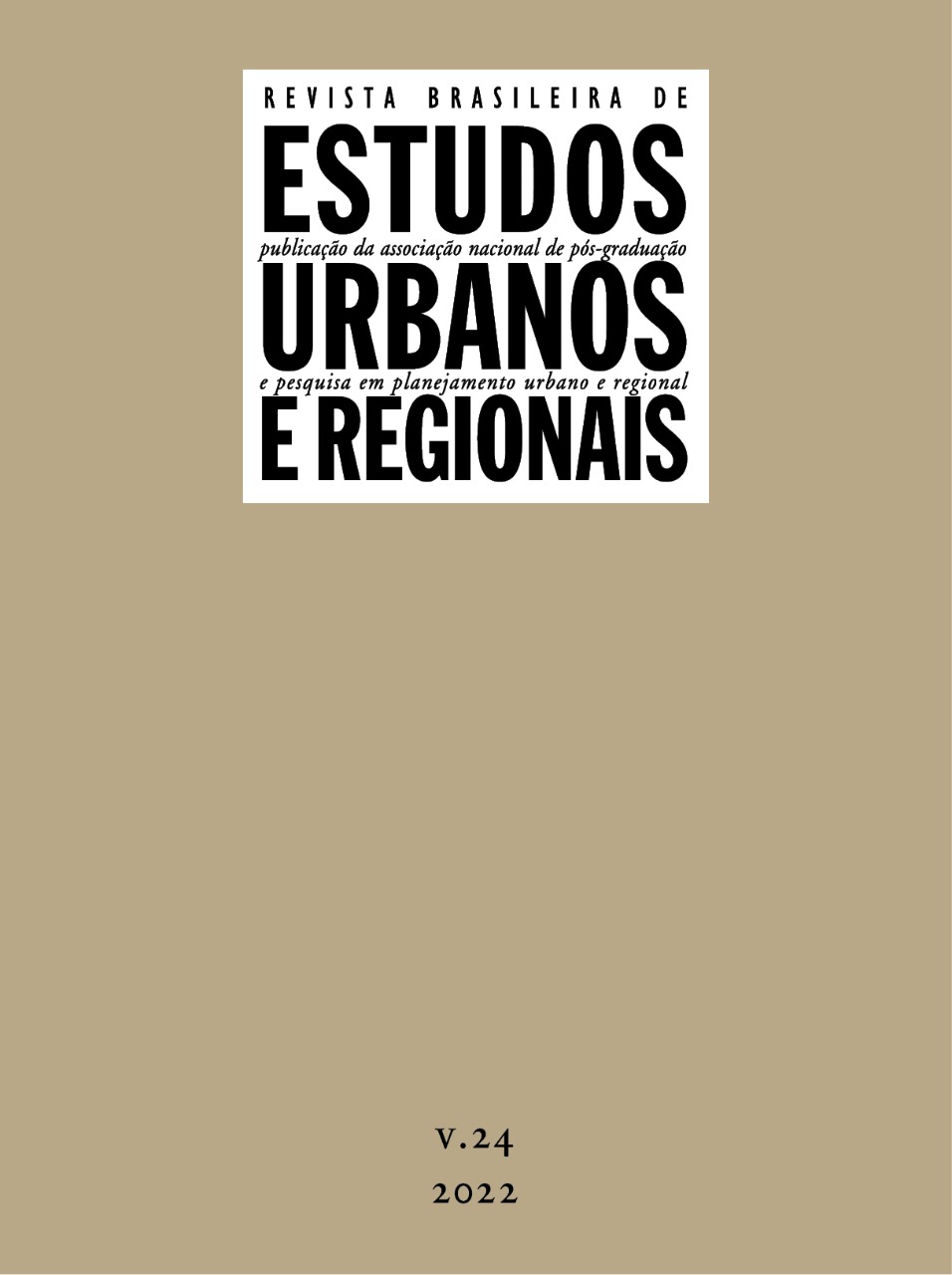Revealed comparative advantages and interregional division of labor in the Brazilian economy
DOI:
https://doi.org/10.22296/2317-1529.rbeur.202205Keywords:
Regional Inequality, Spatial Concentration of Production, Economic DevelopmentAbstract
The objective of this work is to capture possible changes in the insertion mode of regional economies in national value chains using comparative advantage indicators, developed by Béla Balassa and improved by Gérard Lafay, and intra-industry trade indicators developed by Herbert Grubel and Peter Lloyd and improved by Antonio Aquino. Based on inter-regional trade, disaggregated by productive sectors, two findings are extracted. The first is that in terms of aggregate value, industrial production continues to be highly concentrated. The second points to the sedimentation of a second inter-regional division of labor that follows the de-concentration process of industrial production that began in the 1970s. After this period, the participation of the less developed states in the national value chains are gradually reoriented toward the supply of semi-manufactured goods, of low technological intensity and intensive in manpower and raw materials. Thus, there are significantly important changes in the hierarchy of the insertion mode of the regional economies in the national value chains, only possible to be revealed through the availability of the Interstate Input-Output Matrices.
Downloads
References
ANTRÀS, P.; GORTARI, A. de. On the geography of Global Value Chains. Econometrica, 84(4): p. 1553-1598, 2020.
AQUINO, A. Intra-industry trade and inter-industry specialization as concurrent sources of international trade in manufactures. Weltwirtschaftliches Archiv, v. 114, p. 275-296, 1978.
AZZONI, C. R. Indústria e reversão da polarização no Brasil. São Paulo: IPE-USP, 1986.
BALASSA, B. Trade liberalisation and revealed comparative advantage. Manchester School of Economic and Social Studies, v. 33, p. 99-123, 1965.
BALASSA, B. Tariff reductions and trade in manufactures among industrial countries. American Economic Review, v. 56, p. 466-473, 1966.
BALDWIN, R.; VENABLES, A. J. Spiders and snakes: offshoring and agglomeration in the global economy. Journal of International Economics, 90.2, p. 245-254, 2013.
CANO, W. Raízes da concentração industrial em São Paulo. 5. ed. Campinas: Ed. da Unicamp, [1977] 2007.
CANO, W. Desequilíbrios regionais e concentração industrial no Brasil 1930-1970 – 1970-1995. 2. ed. rev. e aum. Campinas: Ed. da Unicamp, 1985.
CANO, W. Desconcentração produtiva regional no Brasil 1970-2010. 3. ed. São Paulo: Ed. da Unesp, 2008.
COUTINHO, L. G.; FERRAZ, J. C. (coord.). Estudo da competitividade da indústria brasileira. Campinas: Papirus, 1995.
DINIZ, C. C. Desenvolvimento poligonal no Brasil: nem desconcentração, nem contínua polarização. Nova Economia, v. 3, n. 1, p. 35-64, 1993.
FURTADO, C. Formação econômica do Brasil. 15. ed. São Paulo: Editora Nacional, [1959] 1977.
GEREFFI, G.; HUMPHREY, J.; STURGEON, T. The Governance of Global Value Chains. Review of International Political Economy, 12(1), p. 78-104, 2005.
GEREFFI, G.; KORZENIEWICZ, M.; KORZENIEWICZ, R. Introduction: global commodity chains. In: GEREFFI. G.; KORZENIEWICZ, M. (ed.). Commodity chains and global capitalism. Westport, CT: Praeger, 1994. p. 1-14.
GRUBEL, H.; LLOYD, P. Intra-Industry trade. The theory and measurement of international trade in differentiated products. London: Macmillan Press, 1975. p. 205.
GUIMARÃES NETO, L. Dinâmica recente das economias regionais brasileiras. Revista Paranaense de Desenvolvimento, n. 86, p. 123-152, set.-dez. 1995.
GUIMARÃES NETO, L. Desigualdades e políticas regionais no Brasil: caminhos e descaminhos. Planejamento e Políticas Públicas, IPEA, Brasília, n. 15, p. 41-95, 1997.
HADDAD, E.; GONÇALVES JÚNIOR, C. A.; NASCIMENTO, T. O. Matriz Interestadual de Insumo-Produto para o Brasil: uma aplicação do Método IIOAS. Revista Brasileira de Estudos Regionais e Urbanos, v. 11, n. 4, p. 424-446, 2017.
KOOPMAN, R.; WANG, Z.; WEI, S.-J. Tracing value-added and double counting in gross exports. The American Economic Review, v. 104, n. 2, p. 459-94, 2014.
KRUGMAN, P. Increasing returns, monopolistic competition, and international trade. Journal of International Economics, 9, p. 469-479, 1979.
KRUGMAN, P. Scale economies, product differentiation, and the pattern of trade. The American Economic Review, 70, n. 5, p. 950-59, 1980.
KRUGMAN, P. Intraindustry specialization and the gains from trade. Journal of Political Economy, 89, p. 959-973, 1981.
LAFAY, G.; HERZOG, C. Commerce international: la fin des avantages acquis. Economica, 1989.
LASSUDRIE-DUCHENE B. Décomposition internationale des processus productifs et autonomie nationale. In: BOURGUINAT, H. (ed.). Internationalisation et autonomie de décision. Paris: Economica, 1982. pp. 45-56.
OLIVEIRA, F. Economia brasileira: crítica à razão dualista. 4. ed. Petrópolis: Vozes, [1972] 1981.
OLIVEIRA, F. de. Elegia para uma re(li)gião: Sudene. Planejamento e conflito de classes. 2. ed. Rio de Janeiro: Paz e Terra, 1977a.
OLIVEIRA, F. de. A economia da dependência imperfeita. Rio de Janeiro: Graal, 1977b.
PACHECO, C. A. A questão regional brasileira pós-1980: desconcentração econômica e fragmentação da economia nacional. 1996. Tese (Doutorado) – Instituto de Economia, Universidade Estadual de Campinas, Campinas, 1996.
PACHECO, C. A. A fragmentação da nação. Campinas: Ed. da Unicamp, 1998.
Downloads
Published
How to Cite
Issue
Section
Categories
License

This work is licensed under a Creative Commons Attribution 4.0 International License.
Authors who publish in this journal agree to the following terms:
1) Authors who publish in RBEUR retain the rights to their work and assign to the journal the right to first publication, performed under the Creative Commons Attribution License that allows work to be shared and assures the recognition of authorship and of the original publication vehicle, to RBEUR.
2) Authors are free to assume additional contracts separately, for publication and non-exclusive distribution of the version of the work published in this journal (e.g., publishing in an institutional repository or as a book chapter), reaffirming the authorship and recognition of the original publication vehicle, to RBEUR.











.png)

